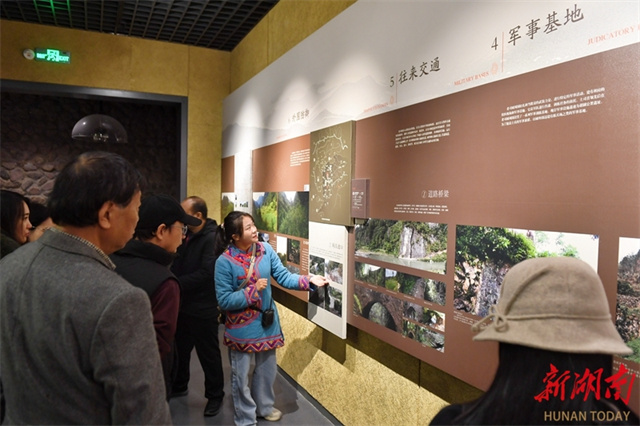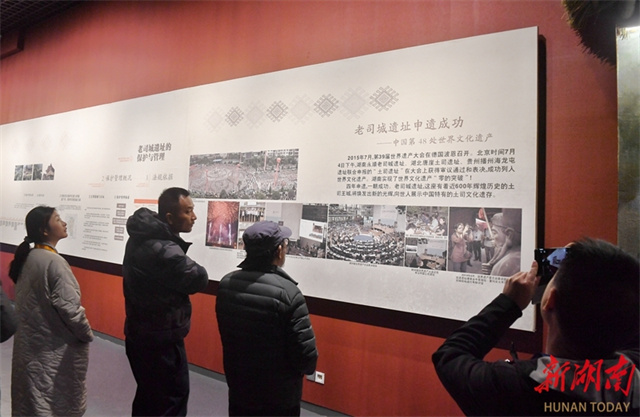湖南省政府门户网 2024-12-01 16:29:24

The photo shows tourists visiting the Laosicheng Museum in Yongshun County. Covering an exhibition area of 2,000 square meters, the Laosicheng Museum serves as an important platform to display the Tusi system, Tusi culture, and the culture of Tujia ethnic group. The museum has launched a series of activities this year, including holding thematic lectures, promoting world cultural heritage knowledge on campus, and releasing cultural creative products. The museum also uses technologies to enhance its service capabilities. (Photo/Xu Xing and Deng Zhengke, Hunan Daily)
The Tusi system is an ancient chieftain system adopted by feudal Chinese emperors to govern ethnic minorities in the southwest from the 13th to the early 20th century. "Tusi" refers to a tribal leader appointed as an imperial official by the central government.

The photo shows tourists visiting the Laosicheng Museum in Yongshun County. Covering an exhibition area of 2,000 square meters, the Laosicheng Museum serves as an important platform to display the Tusi system, Tusi culture, and the culture of Tujia ethnic group. The museum has launched a series of activities this year, including holding thematic lectures, promoting world cultural heritage knowledge on campus, and releasing cultural creative products. The museum also uses technologies to enhance its service capabilities. (Photo/Xu Xing and Deng Zhengke, Hunan Daily)

The photo shows tourists visiting the Laosicheng Museum in Yongshun County. Covering an exhibition area of 2,000 square meters, the Laosicheng Museum serves as an important platform to display the Tusi system, Tusi culture, and the culture of Tujia ethnic group. The museum has launched a series of activities this year, including holding thematic lectures, promoting world cultural heritage knowledge on campus, and releasing cultural creative products. The museum also uses technologies to enhance its service capabilities. (Photo/Xu Xing and Deng Zhengke, Hunan Daily)

The photo shows tourists visiting the Laosicheng Museum in Yongshun County. Covering an exhibition area of 2,000 square meters, the Laosicheng Museum serves as an important platform to display the Tusi system, Tusi culture, and the culture of Tujia ethnic group. The museum has launched a series of activities this year, including holding thematic lectures, promoting world cultural heritage knowledge on campus, and releasing cultural creative products. The museum also uses technologies to enhance its service capabilities. (Photo/Xu Xing and Deng Zhengke, Hunan Daily)

The photo shows tourists visiting the Laosicheng Museum in Yongshun County. Covering an exhibition area of 2,000 square meters, the Laosicheng Museum serves as an important platform to display the Tusi system, Tusi culture, and the culture of Tujia ethnic group. The museum has launched a series of activities this year, including holding thematic lectures, promoting world cultural heritage knowledge on campus, and releasing cultural creative products. The museum also uses technologies to enhance its service capabilities. (Photo/Xu Xing and Deng Zhengke, Hunan Daily)

The photo shows tourists visiting the Laosicheng Museum in Yongshun County. Covering an exhibition area of 2,000 square meters, the Laosicheng Museum serves as an important platform to display the Tusi system, Tusi culture, and the culture of Tujia ethnic group. The museum has launched a series of activities this year, including holding thematic lectures, promoting world cultural heritage knowledge on campus, and releasing cultural creative products. The museum also uses technologies to enhance its service capabilities. (Photo/Xu Xing and Deng Zhengke, Hunan Daily)

The photo shows tourists visiting the Laosicheng Museum in Yongshun County. Covering an exhibition area of 2,000 square meters, the Laosicheng Museum serves as an important platform to display the Tusi system, Tusi culture, and the culture of Tujia ethnic group. The museum has launched a series of activities this year, including holding thematic lectures, promoting world cultural heritage knowledge on campus, and releasing cultural creative products. The museum also uses technologies to enhance its service capabilities. (Photo/Xu Xing and Deng Zhengke, Hunan Daily)
责编:唐煜斯
一审:唐煜斯
二审:秦慧英
三审:禹振华
来源:湖南省政府门户网
我要问



 下载APP
下载APP 报料
报料 关于
关于
 湘公网安备 43010502000374号
湘公网安备 43010502000374号